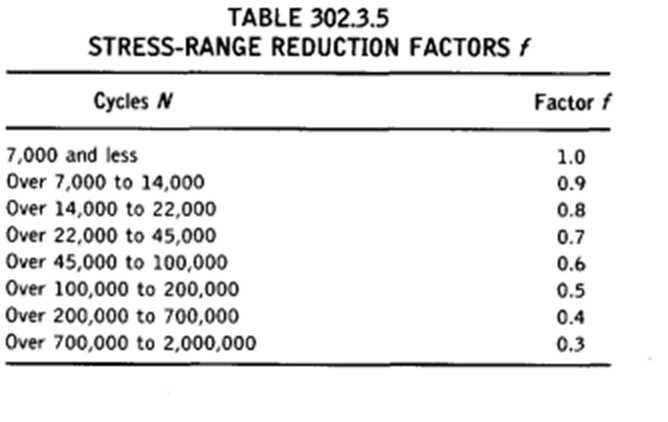Changes to f Factor in ASME B31.3 in the 2022 Edition
In the 2022 edition of ASME B31.3, the f factor was changed. There have been some mixed reactions in articles and social media; hopefully, this blog can put the matter in perspective.
The f factor is used to reduce the allowable displacement stress range to prevent fatigue failure. It is based on welded pipe fatigue tests originally performed in the 1950’s, and included a factor of two on stress as the safety factor. The original f factors were provided in a table, shown below, taken from the 1959 edition. Note that most of the fatigue tests were between 1,000 and 1,000,000 cycles and a slope of the fatigue curve was fit to the data based on the range of data that was available. The below table implied an endurance limit of f=0.5 for greater than 100,000 cycles.

The f factors start with a value of 1.0 for 7,000 or fewer cycles. This was chosen so as not to require the use of the f factor for the vast majority of everyday piping systems. 7,000 cycles is approximately one cycle a day for 20 years.
Additional f factors for greater than 100,000 cycles were added to the 1990 edition, which specifically stated validity up to 2,000,000 cycles. This removed the implication that there was an endurance limit.

In the 2004 edition, the f factor was changed from a table to a plot, as shown below. The plot was intended to show two new changes. First, a minimum f factor of 0.15 was introduced as an endurance limit based on the concepts found in ASME OM-3. The extension of the f factor curve down to 0.15 followed the slope originally proposed by Markl. The other concept is that under certain conditions you can use an f factor greater than 1 if the number of cycles is less than 7,000.

Paulin Research undertook a project to update the stress intensification and flexibility factors, as is now available in B31J. There was then much more available high cycle welded component fatigue data, such as can be found in BS 7608, DNV RP C203, BS 5500 and EN 13445. In a 2008 paper by Hinant and Paulin, a revised slope was proposed as the higher cycle fatigue data revealed that the slope of the fatigue curve developed by Markl was too shallow, making it progressively less conservative at higher numbers of cycle. The new curve also terminates at a minimum f value of 0.15, but gets there at about 2.4 million cycles rather than about 100 million cycles. The new fatigue curve was used in the assessment of the welded component fatigue data to develop stress intensification factors now in B31J and is reflected in the new f curve, shown below.

The impact of the change in fatigue curve slope on design of typical process plant piping is essentially nonexistent. Most process plant piping have numbers of displacement cycles less than 7,000. And 2,000,000 cycles would be 11 cycles per hour for 20 years.
There is no requirement to assess existing piping to new ASME B31.3 rules. And in any case, there is every reason to expect that the prior f factor tables were conservative to at least 2,000,000 cycles. Conditions exceeding those numbers of cycles would, for example, be displacement of piping on ships and offshore platforms due to waves.
If an existing piping system is subject to a very high number of displacement cycles, the appropriate measure to take would be to make sure your mechanical integrity program includes periodic inspection for fatigue cracking in fatigue vulnerable components.
